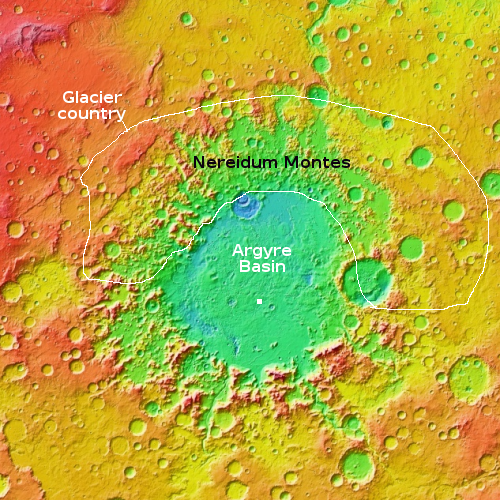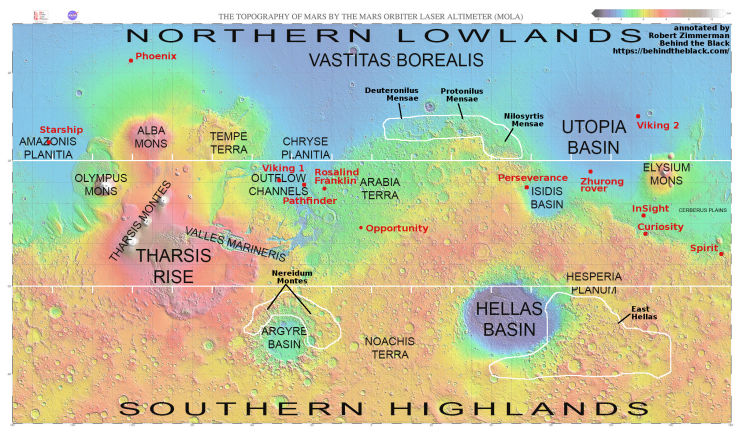A congregation of Martian dust devils
Cool image time! The photo to the right, rotated, cropped, reduced, and sharpened to post here, was taken on September 9, 2022 by the high resolution camera on Mars Reconnaissance Orbiter (MRO). It shows a spot on Mars where, as indicated by the many many tracks, dust devils routinely develop and travel across the surface.
Though this whole region appears to favor dust devils, within it are places that are even more favored. For example, the number of tracks on the northern and eastern slopes of that small hill at center left practically cover the surface, while the hill’s western and southern slopes are almost untouched.
Both the overview map and the global Mars map below provide the full context.

The white dot in the center of Argyre Basin marks the location of today’s picture. The full global map below places Argyre on Mars, in the southern mid- to high- latitudes.
Argyre Basin, though not as deep or as large as Hellas Basin, is still the second largest such basin on Mars, about 1,100 miles in diameter with its lowest elevation 17,000 feet below the surrounding southern cratered highlands. Like Hellas, it is thought to be the remains of major impact.
Relatively few high resolution images have been taken by MRO within Argyre Basin since the orbiter reached Mars orbit in 2006, as shown by the red spots on the archive map here. Even this photo was not requested by a scientist pursuing a specific research project. Instead, it was taken in order to fill a gap in MRO’s picture-taking schedule to maintain the camera’s temperature. When such gaps occur, the MRO science team picks a random location to take a picture. Sometimes they capture something baffling, sometimes not. In this case they snapped a picture of a location where dust devils like to gather, for reasons unknown.
I suspect that the reasons Argyre Basin has been largely ignored by researchers is because there are just too many more other exciting things on Mars to study, especially in connection with water. For example, the areas outlined with a white line on the global map below are regions where many glaciers have been identified. In these places a lot of MRO pictures have been taken.
This basin just hasn’t yet sparked enough interest yet. That will change eventually, but it will simply take time.

On Christmas Eve 1968 three Americans became the first humans to visit another world. What they did to celebrate was unexpected and profound, and will be remembered throughout all human history. Genesis: the Story of Apollo 8, Robert Zimmerman's classic history of humanity's first journey to another world, tells that story, and it is now available as both an ebook and an audiobook, both with a foreword by Valerie Anders and a new introduction by Robert Zimmerman.
The print edition can be purchased at Amazon or from any other book seller. If you want an autographed copy the price is $60 for the hardback and $45 for the paperback, plus $8 shipping for each. Go here for purchasing details. The ebook is available everywhere for $5.99 (before discount) at amazon, or direct from my ebook publisher, ebookit. If you buy it from ebookit you don't support the big tech companies and the author gets a bigger cut much sooner.
The audiobook is also available at all these vendors, and is also free with a 30-day trial membership to Audible.
"Not simply about one mission, [Genesis] is also the history of America's quest for the moon... Zimmerman has done a masterful job of tying disparate events together into a solid account of one of America's greatest human triumphs."--San Antonio Express-News
Cool image time! The photo to the right, rotated, cropped, reduced, and sharpened to post here, was taken on September 9, 2022 by the high resolution camera on Mars Reconnaissance Orbiter (MRO). It shows a spot on Mars where, as indicated by the many many tracks, dust devils routinely develop and travel across the surface.
Though this whole region appears to favor dust devils, within it are places that are even more favored. For example, the number of tracks on the northern and eastern slopes of that small hill at center left practically cover the surface, while the hill’s western and southern slopes are almost untouched.
Both the overview map and the global Mars map below provide the full context.

The white dot in the center of Argyre Basin marks the location of today’s picture. The full global map below places Argyre on Mars, in the southern mid- to high- latitudes.
Argyre Basin, though not as deep or as large as Hellas Basin, is still the second largest such basin on Mars, about 1,100 miles in diameter with its lowest elevation 17,000 feet below the surrounding southern cratered highlands. Like Hellas, it is thought to be the remains of major impact.
Relatively few high resolution images have been taken by MRO within Argyre Basin since the orbiter reached Mars orbit in 2006, as shown by the red spots on the archive map here. Even this photo was not requested by a scientist pursuing a specific research project. Instead, it was taken in order to fill a gap in MRO’s picture-taking schedule to maintain the camera’s temperature. When such gaps occur, the MRO science team picks a random location to take a picture. Sometimes they capture something baffling, sometimes not. In this case they snapped a picture of a location where dust devils like to gather, for reasons unknown.
I suspect that the reasons Argyre Basin has been largely ignored by researchers is because there are just too many more other exciting things on Mars to study, especially in connection with water. For example, the areas outlined with a white line on the global map below are regions where many glaciers have been identified. In these places a lot of MRO pictures have been taken.
This basin just hasn’t yet sparked enough interest yet. That will change eventually, but it will simply take time.

On Christmas Eve 1968 three Americans became the first humans to visit another world. What they did to celebrate was unexpected and profound, and will be remembered throughout all human history. Genesis: the Story of Apollo 8, Robert Zimmerman's classic history of humanity's first journey to another world, tells that story, and it is now available as both an ebook and an audiobook, both with a foreword by Valerie Anders and a new introduction by Robert Zimmerman.
The print edition can be purchased at Amazon or from any other book seller. If you want an autographed copy the price is $60 for the hardback and $45 for the paperback, plus $8 shipping for each. Go here for purchasing details. The ebook is available everywhere for $5.99 (before discount) at amazon, or direct from my ebook publisher, ebookit. If you buy it from ebookit you don't support the big tech companies and the author gets a bigger cut much sooner.
The audiobook is also available at all these vendors, and is also free with a 30-day trial membership to Audible.
"Not simply about one mission, [Genesis] is also the history of America's quest for the moon... Zimmerman has done a masterful job of tying disparate events together into a solid account of one of America's greatest human triumphs."--San Antonio Express-News



I had thought there was a discussion here somewhere concerning the collective noun for dust devils. I may be confusing it with something else. However, the question stands: what is the collective term for dust devils? One may assume gender-neutrality.
Suggest ‘whirl’.
Blair-
Good one.